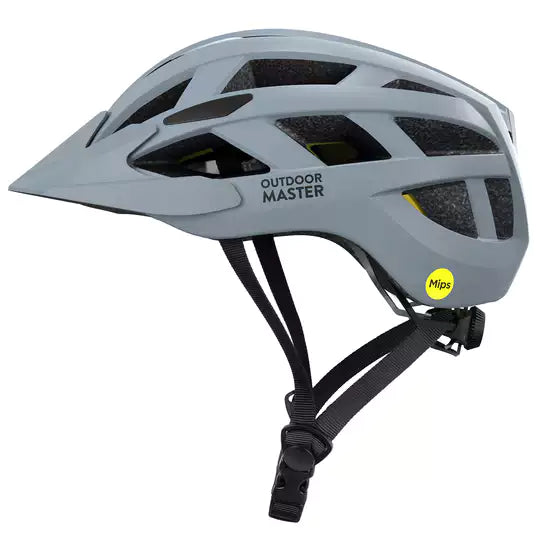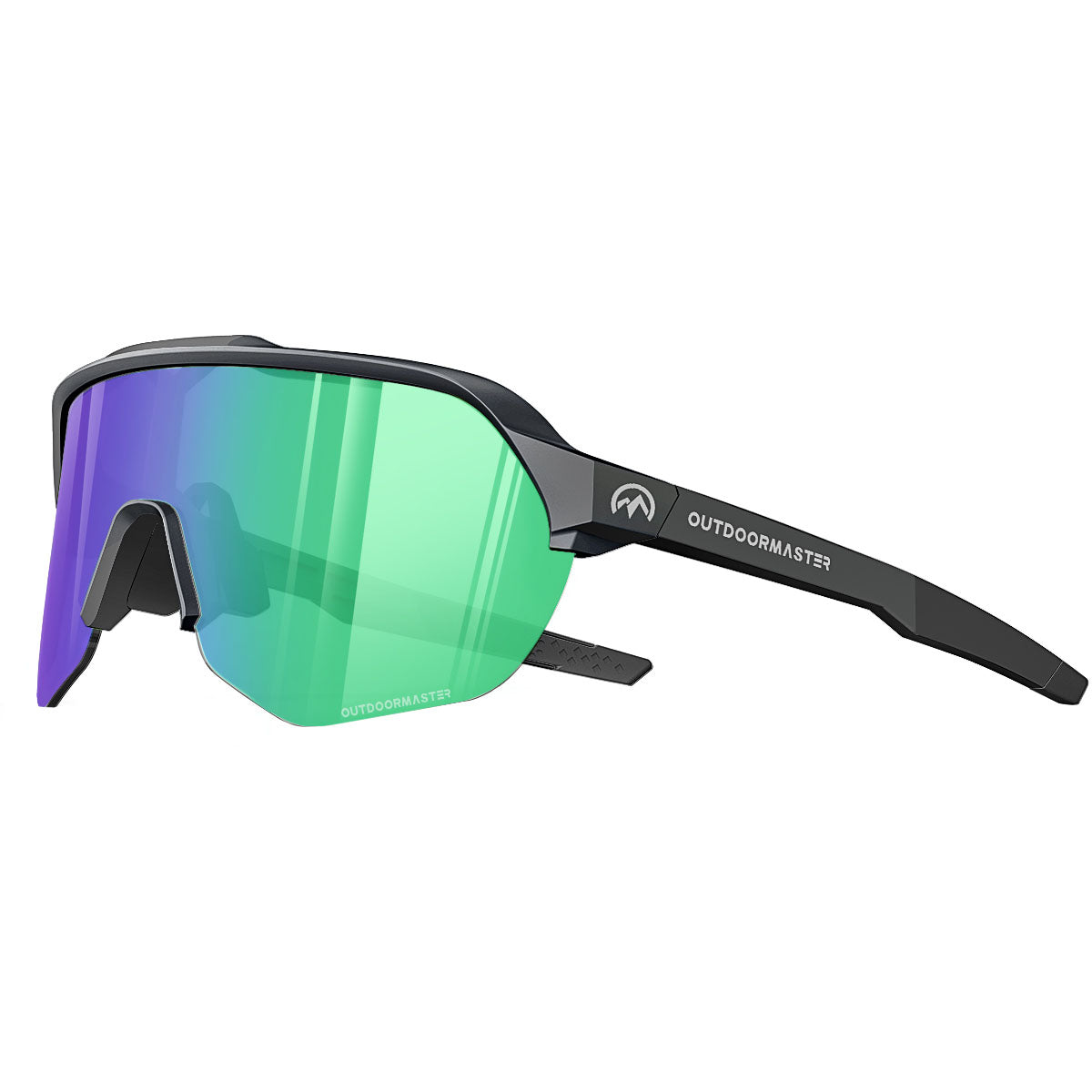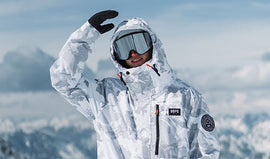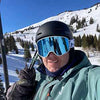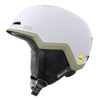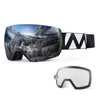
Skiing is a popular winter sport that attracts people from all walks of life. While the basics of skiing are easy to learn, there are some terms and phrases that are used by skiers which may be unfamiliar to those who have never hit the slopes before. Here is a list of many common ski slang terms so that you can talk like a pro on your next ski trip.
Here is our complete list of ski slang in alphabetical order
A-E
Alpine skiing: Skiing downhill, often on groomed trails.
Apres-ski: Activities or socializing that takes place after skiing for the day. This can include drinking, dining, and dancing.
Avy: Short for avalanche.
Backcountry: Unmarked, ungroomed terrain that is accessed by skiing or snowboarding off of a ski trail.
Bagel: When a skiier or snowboard ends a trick by spinning 270 degrees in the opposite direction they entered the trick
Bail: To intentionally jump off of a ski or snowboard, usually to avoid crashing.
Bar up/Bar down: When a skier raises or lowers the bar that is used to keep skiers and snowboarders on the chairlift.
Base: The bottom packed layer of snow on the mountain. Ski resorts will report the depth of their snow base. The base is also the bottom of your skis.
Black Ice: A thin layer of black ice that can form on top of groomers. It is hard to see and can be dangerous.
Black Run or Black Diamond: The most difficult ski run that is for expert skiers and snowboarders.
Blower Powder: Powder that is so light it blows away when you ski or snowboard through it.
Blue Run: A more difficult ski run that is for intermediate skiers and snowboarders.
Bluebird: A clear, sunny day with blue skies.
Bombing: To ski or snowboard down the hill as fast as possible.
Bony: When the snow is hard and icy and feels like you are skiing over bones.
Bowl: A wide, open area of terrain that is often steep and treeless.
Bunny slope: A beginner's slope that is short and relatively easy to ski or snowboard on.
Bumps: Mound-like formations of snow that form on ski trails.
Butter or butta: Snowboarding or skiing where you put all your weight on either the tip or tail of your skis or board and lifting up the other end into the air.
Button lift: A type of ski lift that uses a circular disc, or “button,” to attach the skier to the lift.
Camber: The amount of downward curvature in a ski or snowboard. Cambered skis are best for groomers and hardpack snow.
Carving: Turning with skis so that the edges cut deep into the snow and don't skid leaving a smooth deep cut track
Catch an edge: When the edge of a ski or snowboard digs into the snow and causes the person to fall.
Champagne Powder: Very light, dry powder.
Chatter: When a skier's skis vibrate uncontrollably, usually at high speeds. This can be caused by skiing on hard or icy snow.
Chinese Downhill: When everyone starts skiing at the same time and whoever gets to the bottom first wins, with no rules. This term comes from the skiing comedy movie “Hot Dog: The Movie”
Chowder: Heavy, chunked up snow that is left after people have skied out all the powder on a fresh snow day.
Chute: A steep and narrow section of a ski slope.
Corduroy: Snow that has been groomed into evenly spaced parallel grooves.
Corn: Small soft pellets of snow that form when the temperature gets warm during the day and then cools off at night. This type of snow forms in the spring when temperatures warm up.
Cornice: An overhanging edge of snow, often found at the top of a ridge.
Couloir: A steep, narrow gully that is often found on a mountainside. Also referred to as a chute.
Crevasse: A large crack in the snow and ice, usually found on glaciers. They can be very dangerous if you fall into one. They are rarely encountered within ski resort boundaries but it can happen.
Cross Country Skier: A person who skis on groomed trails in the woods or mountains. They use a different type of ski than alpine skiers. It is more like hiking on skis.
Crud: Heavy, wet snow that has been skied through and hardened.
Crust: Frozen, crusted-over snow that can be difficult to ski or snowboard on.
Death Cookies or Cornice Cookies: Large, dangerous chunks of snow that have fallen from a cornice (an overhanging edge of snow) and onto the ski slope.
Digging Trenches: Carving turns so well that they leave a deep cut in the snow. This is a sign of expert ski technique
Double Black: A very difficult ski run or terrain
Downhill: A type of ski race that is the fastest and most dangerous. The gates are spaced far apart and the skiers reach high speeds. Skiers tuck for most of the race and go over large high speed jumps.
Drag lift: A type of ski lift that drags you up the hill while you stand on the snow surface.
Dumping: When a lot of snow falls in a short period of time.
Dust on crust: When there is a thin layer of powder snow over a crusty hard base.
Epic Pass: A season pass by Vail Resorts that lets you ski or ride at many resorts around the world at a low price. Epic Pass resorts are known for over crowding and poor customer service.
F-J
Face plant: When a skier or snowboarder falls and their face hits the snow.
Face shot: When powder snow is thrown up into the air and lands on the skier's or snowboarder's face.
Fall Line: The most direct route down a mountain.
First Chair: The first chairlift of the day. First chair is most prized on powder days where it means getting the first tracks in fresh snow.
First Tracks: The first set of tracks on a freshly groomed or powdery run.
FIS: The International Ski Federation, the governing body for competitive skiing.
Flat light: When the lighting conditions are flat and there is little contrast between the shadows and the sunlit areas. This can make it difficult to see bumps, moguls, and other terrain features. Using the right ski goggles with a good flat light lens can make seeing in flat light much easier.
Freeride: skiing or snowboarding off groomed trails or in powder snow. It is also a type of competitive skiing where the skier must do tricks and jumps.
Freestyle skier: A skier who performs tricks and jumps, often in a halfpipe or terrain park.
French fry turn: A type of turn where the skier keeps their skis parallel to each other but points their tips inward, forming a “French fry” shape.
Freshies: Untracked powder that has fallen overnight or early in the morning.
Fun box: A box in the terrain park that you can slide across. They are called fun boxes until you fall on one, at which point they aren't fun anymore.
Fun Police: An overly strict and aggressive ski patroller
Gaper: A novice skier who makes obvious errors or wears their equipment incorrectly. They frequently have a large goggle gap between their goggles and helmet.
Gaper Day: Many ski resorts have a Gaper Day. This is typically the last day the ski resort is open in the spring. It is celebrated by skiers wearing crazy or retro ski outfits and events such as pond skimming.
Giant Slalom: A type of downhill ski race where the skier must go around poles that are spaced further apart than in a slalom race.
Glade: A tree skiing area that has been cleared of brush or the snow is deep enough to cover the brush. The trees are nicely spaced apart so you have room to turn between them.
Goggle Gap: The gap between your ski helmet and ski goggles. It is caused by wearing a thick hat under your helmet or having a mismatched ski helmet and goggles.
Golf Balls: Small balls of icy snow created by the grooming machines.
Gondola: A type of ski lift that is enclosed and typically carries four to ten skiers at a time.
Gondy: Another word for a gondola lift
Goofy: Snowboarding with your right foot forward.
Gnar: This term is used to describe challenging or dangerous terrain. It can also be used to describe a particularly good run.
Grab: To grab the edge of a ski or snowboard with your hand while performing a trick
Green Run: An easy ski run that is often beginner friendly.
Groomers: Groomed ski runs. They are smooth and fast in the morning before being skied out.
Hard pack: When the snow has been packed down by skiers and snowboarders and becomes firm and icy.
Heli skiing: Skiing or snowboarding using a helicopter for a lift. This is usually done in remote mountain areas with deep powder snow.
Hot Dogging: Skiing fast in a crazy manner doing all sorts of jumps and tricks.
Huck: To purposely throw oneself off of a large jump or cliff.
Ice Coast: The East Coast of the United States where the snow is often icy.
In bounds: The area of the ski resort that is patrolled by the ski patrol. It is safe to ski in this area.
Japowuary: Northern Japan is known for getting legendary amounts of snow in the month of January every year.
J-bar: A type of ski lift that pulls skiers up the hill using a J-shaped bar.
Jerry: A novice skier or snowboarder or advanced skiier or snowboarder who has no clue what they are doing and may be a harzard to others. This term was popularized by the website Jerry of The Day.
Jib: Taking small jumps off terrain park obstacles or other natural bumps and jumps
K-O
Kicker: A jump that is made with a man-made ramp.
Killer: An expert skier or snowboarder.
K12: A legendary ski run that was the location for a ski race showdown between Lane Meyers and Roy Stalin in the skiing comedy “Better Off Dead”
Lift line: The line of people waiting to get on the chairlift.
Lift Ticket: The ticket you need to ride the ski lift.
Liftie: A person who works at a ski resort and helps load and unload people from the chairlifts.
Little Ripper: A young, skilled skier or snowboarder.
Magic Carpet: A conveyor belt that is used to help people get up beginner ski runs. They are often found on beginner runs in the learning area.
Mashed Potatoes: Wet heavy slushy snow that has the consistency of mashed potatoes. This snow is most common when it rains right after snowing.
Nordic skiing: Skiing on flat terrain, also known as cross country skiing.
Nuking: When it is snowing so hard that you can't see.
Off-piste: Skiing or snowboarding on ungroomed terrain.
Out of bounds: The area of the mountain that is not patrolled by the ski patrol. It can be dangerous to ski here because there are no avalanche control measures and no one to help if you get hurt.
P-T
Parallel turn: A type of turn where the skis are parallel to each other.
Park Rat: Someone who spends most of their time in the terrain park.
Piste: A groomed ski trail.
Pizza turn: A type of turn where the skier pushes their skis out to the sides, forming a “pizza slice” shape. This is often used by novice skiers.
Packed Powder: Hard pack groomed snow. There is nothing powdery about packed powder.
Planker: A person who only skis, they do not snowboard.
Pond Skimming: An event held by many ski resorts in the spring where skiers and snowboards try to ski across a pond without falling in the water.
Pole plant: When a skier plants their pole in the snow to help with timing and balance while turning.
Pop: The little bit of air you get when you skiing or riding over a small jump.
Pow: Short for powder. Powder snow is deep, soft, and what every skier dreams of skiing in.
Powder day: A day when there is a lot of fresh powder snow.
Powder hound: A skier who is obsessed with skiing in powdery snow conditions.
Powder stash: A hidden area of powder that has not been skied yet.
Power hour: The last hour of the ski day when most people have hit the bars or hot tub and the slopes are uncrowded and lift lines short.
Pretzel: When a skier or snowboard ends a trick by spinning 270 degrees in the same direction they entered the trick
Quad: A type of ski lift that carries four skiers at a time.
Quiver: A person's collection of skis or snowboards.
Rail: A feature in a terrain park made from a metal rail that you can slide down.
Rip: To ski quickly or aggressively.
Rocker: The amount of upward curvature in a ski. Rockered skis are best for powder and deep snow.
Rocker-Camber-Rocker: An all mountain ski design that has camber in the middle and rocker at the tip and tail.
Run out: The area at the bottom of the ski slope where it flattens out.
Safety Bar: The metal bar that is found on the back of a chairlift. It is used to prevent skiers and snowboarders from falling out of the chair.
Sastrugi: Wavy, ridged patterns that form in the snow from wind blowing across it.
Season Pass: A pass that allows you to ski all season long at one resort or a group of resorts.
Send or Send It: To attempt a trick or difficult ski run. You may or may not actually land the trick or finish the fun without falling.
Shotski: A ski that has shot glasses mounted to it. The shots are drank by a group of skiers at once by lifting up the ski and drinking from it.
Sick: When a skier or snowboarder performs a trick that is very impressive.
Side Country: The area outside of the ski resort boundaries. Back country that is immediately next to a ski resort and accessed through gates from the ski area.
Sidecut: The amount of narrowing a ski has around the middle of the ski. A ski with a lot of sidecut is wide at the tip and tail and narrow at the center.
Sketchy: When a skier or snowboarder is skiing a run or performing a trick that is risky or dangerous.
Ski In, Ski Out: A place to stay that is close to the ski resort so you do not have to drive. You can just ski right to your hotel or condo.
Ski Binding: A device that holds your ski boots onto your skis.
Ski Brake: A set of spring loaded brakes on your skis that keeps them from sliding away out of control and hurting someone when they come off in a fall.
Ski bum: Someone who leads a carefree lifestyle centered around skiing and snowboarding. They typically work as a liftie, bartender, ski instructor, or other ski resort centered career.
Ski Bunny: A beautiful woman who dresses in sexy ski clothes to attract attention but may or may not actually ski very well.
Ski lift: A mechanical device that is used to transport skiers up a ski slope.
Ski length: The size of a ski, usually measured in centimeters. Skis range from around 140cm to 190cm.
Ski Patrol: The people who help injured skiers, set up ski races, do avalanche control, and generally keep the mountain safe.
Skins: Removable strips of fabric that are attached to the bottom of skis, used for uphill travel.
Slalom: A type of downhill ski race where the skier must go around poles that are spaced close together. A slalom race has the tightest spaced poles.
Sleigh ride: When a skier or snowboarder is out of control and sliding down the slope on their stomach or back.
Sluff: Wet, heavy snow that slides down the mountain. It can be dangerous because it can cause an avalanche.
Snowcat or cat: A large tracked vehicle that is used to groom the snow and build terrain park features.
Snowplow turn: A type of turn where the skier keeps their skis pointed inwards and forms a wedge shape. This is often used by novice skiers.
Spine: A ridge in the snow that extends down the mountain.
Steezy/Steez: A cool move that was down with lots of style.
Stoke: This term is used to describe the feeling of excitement and anticipation that comes with skiing.
Stomp: To land a trick perfectly.
Straight lining: When a skier or snowboarder points their skis or snowboard straight down the hill and goes as fast as they can.
Strap in: Stopping to strap on snowboard bindings. All snowboarders have to strap in after getting off the lift.
Super G: A type of downhill ski race that with gates spaced farther apart than a giant slalom.
Superpipe: A half pipe that is much larger than a normal half pipe. It is often used in competitions such as the Olympics.
Switch: Snowboarding with your rear foot forward or skiing backwards.
T-bar: A type of ski lift that pulls 2 skiers up the hill using a T-shaped bar that goes between them.
Table top: A larger jump in a terrain park that is flat in the middle so you can land on it without going over the back.
Tail: The back end of the ski.
Telemark: A type of skiing in which the skier drops one knee to the snow while turning. Telemark skis are similar to cross country skis. The heels are not attached to the ski.
Tight: A really well executed jump or trick
Tip: The front end of the ski.
Tomahawk: When a skier falls and starts tumbling with arms and legs fully extended rotating about their waist. It resembles the motion a tomahawk makes after being thrown.
Tracked out: When all the powder has been skied and it is just packed down crud snow.
Traverse: To ski or hike across a slope instead of down it.
Tree well: A hole in the snow that forms around trees because the tree warms up the snow and melts it. They can be dangerous because people can get stuck in them and suffocate.
Triple Black: A ski run or terrain that is so difficult it is only for the most experienced skiers and snowboarders.
Twin tip: A type of ski that is symmetrical, with the ability to ski backwards.
Tuck: To tuck your knees into your chest and point your skis straight down the hill, often used to gain speed.
U-Y and Numbers
Ullr: The Norse god of snow. Many ski resorts have Ullr Festivals to try and bring more snow. The most famous Ullr Fest occurs at Breckenridge every December
Waist Deep: When the powder snow is so deep it comes up to your waist. In reality, it probably only was boot deep but no one needs to know that.
Waist width: The width of the middle of the ski.
White room: When you are skiing or snowboarding and everything around you is white because of the fresh powder.
Wind hold: When the ski lifts aren't running because it is too windy.
Wind Lip: An accumulation of snow that is blown up by the wind onto a leeward slope (a slope that is facing away from the wind).
Whiteout: When it is snowing so hard that you cannot see.
Wipe Out: A spectacular big fall.
Yard sale: When a skier or snowboarder falls and their equipment is scattered across the slope. To be a full yard sale you must lose both skis and both poles. Bonus points if anything more comes off.
6 Pack: A type of ski lift that carries six skiers at a time.
8 Pack: A type of ski lift that carries eight skiers at a time.
Now that you know some common ski slang terms, you'll be able to hold your own on the slopes and sound like a pro! Let us know if we missed anything and we'll add it to the list.


